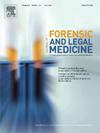Analysis of 14 years (2009–2022) of suicides and homicides involving the use of weapons recorded at the Milan medicolegal institute: update and comparison with the period 1993–2008
IF 1.2
4区 医学
Q3 MEDICINE, LEGAL
引用次数: 0
Abstract
Firearms and cutting/stubbing weapons continue to be primary methods through which both self-inflicted and interpersonal violence manifest with forensic and judicial consequences. Hence, conducting an updated study on suicide and homicide involving these weapons in Milan, Italy, during 2009–2022 was deemed appropriate. This study includes comparisons with a similar analysis spanning 1993–2008, allowing for a comprehensive exploration of changes over a 30-year period in the misuse of firearms and cutting/stubbing weapons within the same geographical area. Overall, there has been a notable decrease in homicides overall (from 54 % to 44 %), particularly those involving firearms (from 53.5 % to 36.5 %), alongside an increase in homicides committed with cutting/stubbing weapons (from 46.5 % to 63.5 %). However, when considering homicides and suicides together, firearms still account for the majority of deaths (56.7 % vs 43.3 %, ratio 1.3:1), though the gap has narrowed compared to previous years. Moreover, there has been a rise in homicides occurring in domestic settings (>40 %) with family members as perpetrators (37 %), and an increase in cases involving legally owned firearms (from 18 % to 34 %). Concurrently, the proportion of suicides has also increased (from 46 % to 56 %), highlighting the prevalent use of firearms (72.5 %). Overall, a different scenario emerges compared to the past, yet the misuse of firearms and cutting/stubbing weapons remains a persistent issue in society. This underscores the need for ongoing monitoring of such incidents and targeted efforts for prevention and regulation.
对米兰法医学研究所记录的14年(2009-2022年)涉及使用武器的自杀和杀人案件的分析:与1993-2008年期间的更新和比较
枪支和切割/戳头武器仍然是造成自我暴力和人际暴力的主要手段,造成法医和司法后果。因此,在2009年至2022年期间在意大利米兰进行一项涉及这些武器的自杀和杀人的最新研究被认为是适当的。这项研究包括与1993年至2008年的类似分析进行比较,以便全面探索30年来同一地理区域内枪支滥用和切割/stub武器的变化。总体而言,凶杀案总体上有显著下降(从54%下降到44%),特别是涉及枪支的凶杀案(从53.5%下降到36.5%),与此同时,使用切割/存根武器的凶杀案(从46.5%上升到63.5%)有所增加。然而,如果将他杀和自杀一起考虑,枪支仍然占死亡人数的大多数(56.7%对43.3%,比例为1.3:1),尽管与前几年相比差距有所缩小。此外,发生在家庭环境中的杀人案(40%)以家庭成员为肇事者(37%),涉及合法拥有的枪支的案件(从18%增加到34%)也有所增加。与此同时,自杀的比例也有所增加(从46%增加到56%),突出了枪支的普遍使用(72.5%)。总的来说,与过去相比,出现了不同的情况,但滥用枪支和切割/存根武器仍然是社会上一个持续存在的问题。这强调需要不断监测这类事件,并有针对性地努力进行预防和管制。
本文章由计算机程序翻译,如有差异,请以英文原文为准。
求助全文
约1分钟内获得全文
求助全文
来源期刊

Journal of forensic and legal medicine
MEDICINE, LEGAL-
CiteScore
2.70
自引率
6.70%
发文量
106
审稿时长
57 days
期刊介绍:
The Journal of Forensic and Legal Medicine publishes topical articles on aspects of forensic and legal medicine. Specifically the Journal supports research that explores the medical principles of care and forensic assessment of individuals, whether adult or child, in contact with the judicial system. It is a fully peer-review hybrid journal with a broad international perspective.
The Journal accepts submissions of original research, review articles, and pertinent case studies, editorials, and commentaries in relevant areas of Forensic and Legal Medicine, Context of Practice, and Education and Training.
The Journal adheres to strict publication ethical guidelines, and actively supports a culture of inclusive and representative publication.
 求助内容:
求助内容: 应助结果提醒方式:
应助结果提醒方式:


